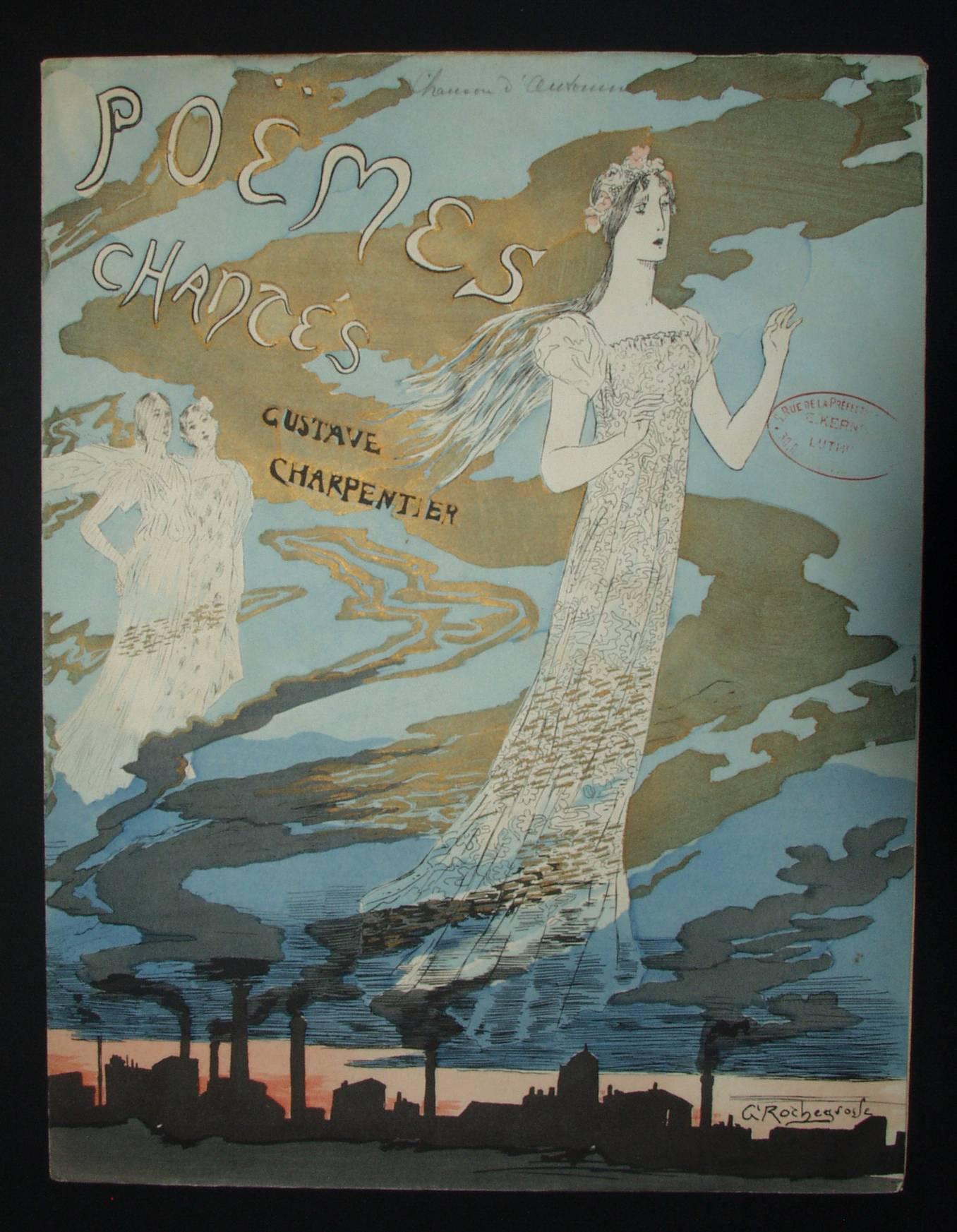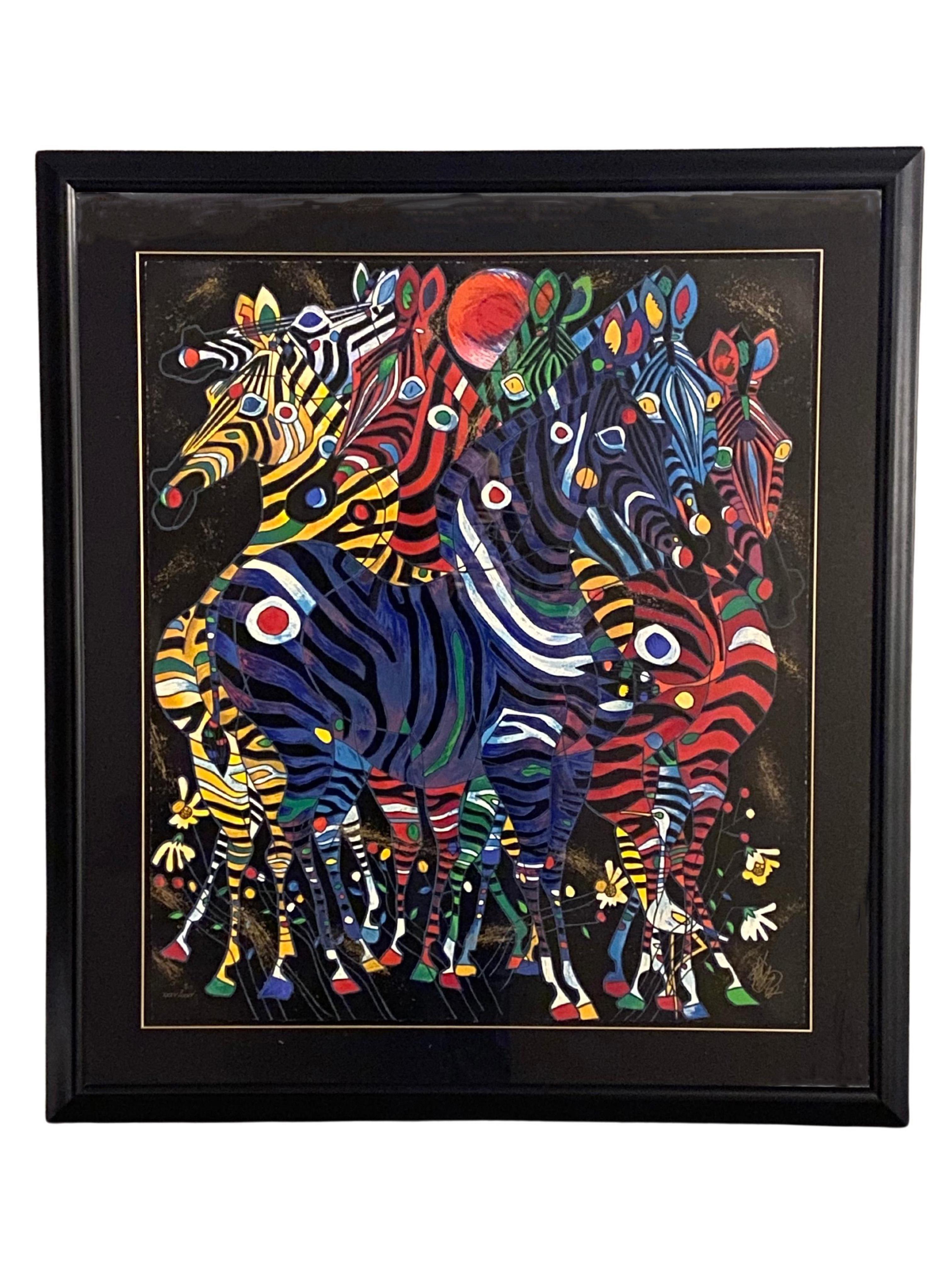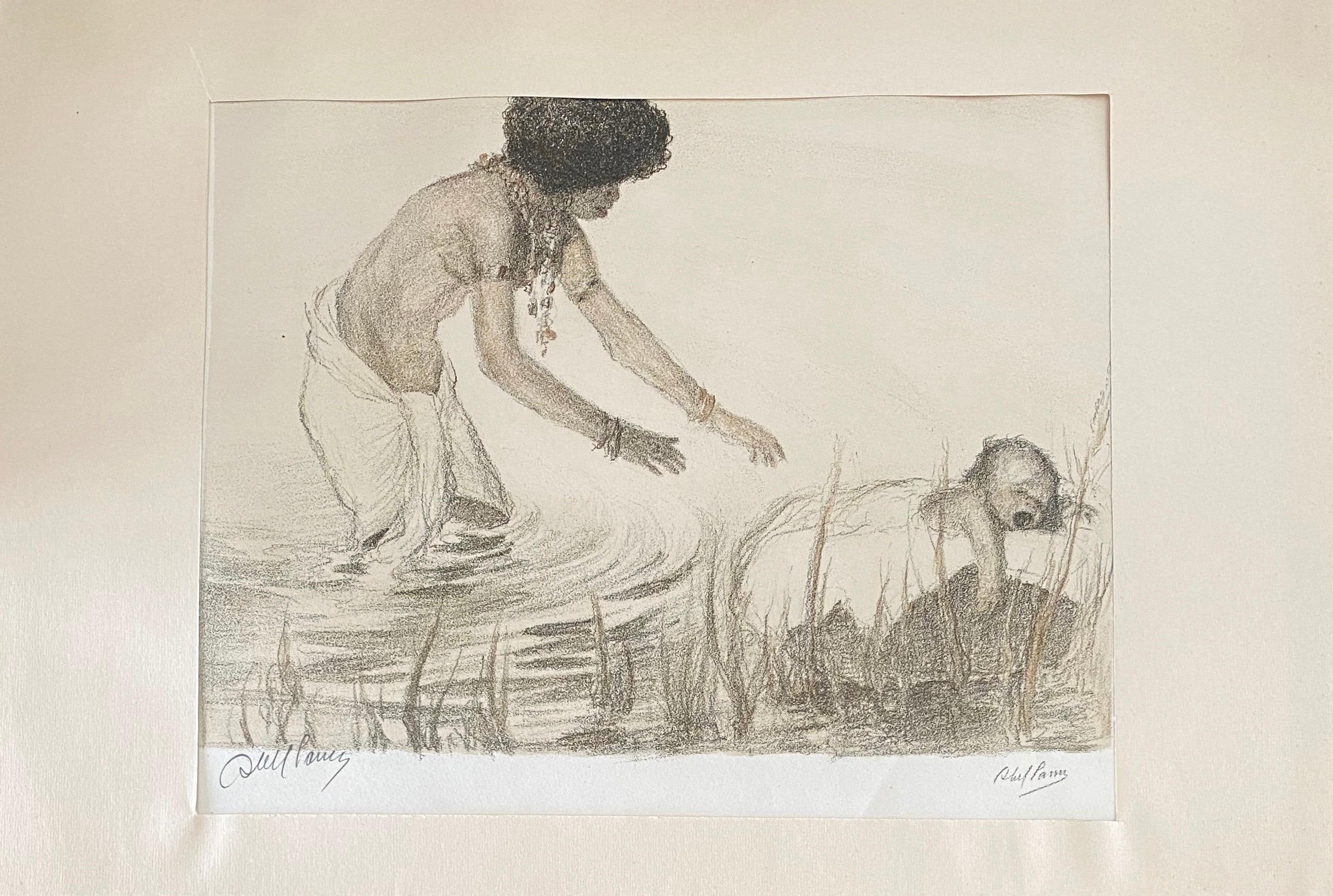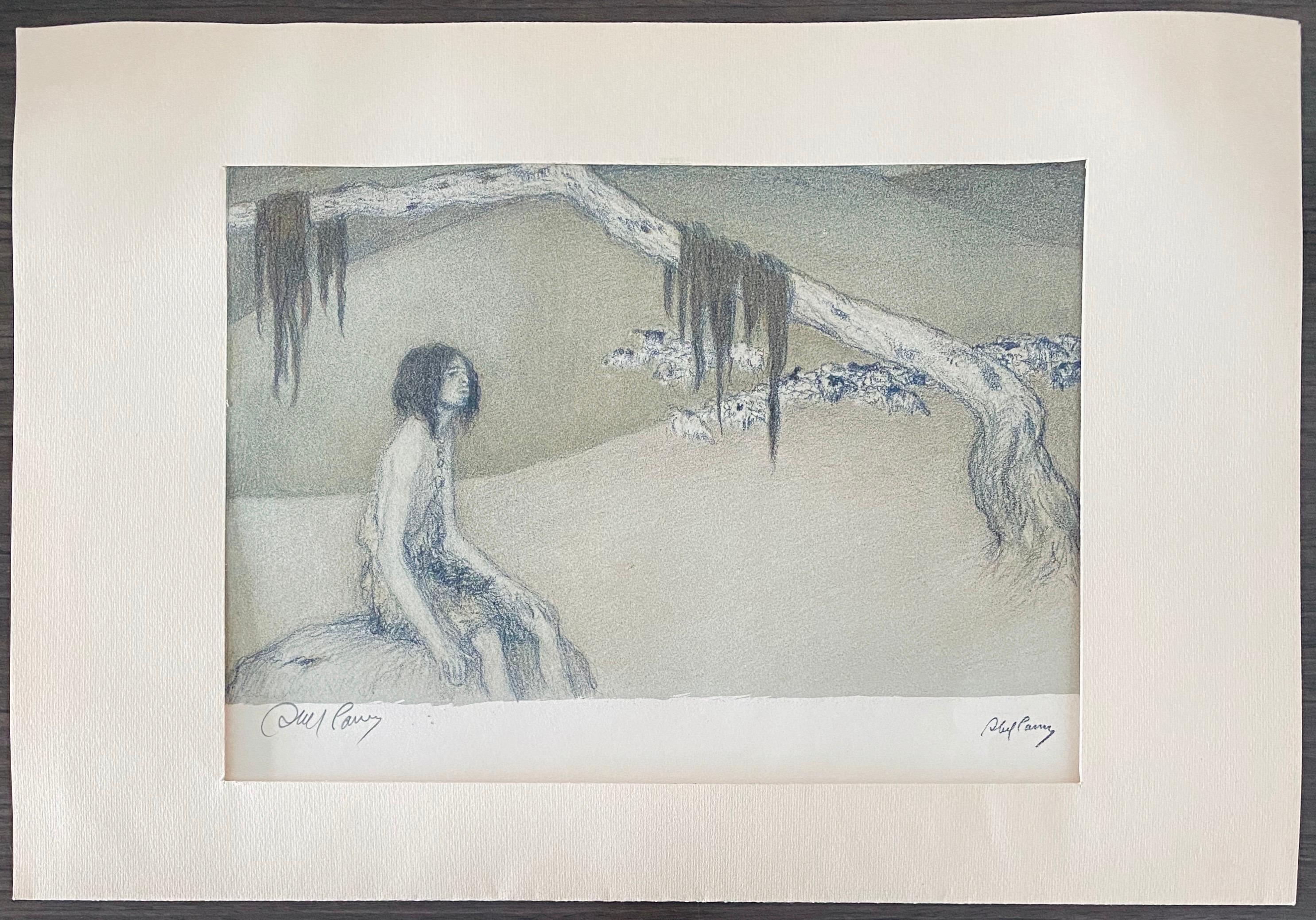Items Similar to The Secret Paul Delvaux Lithograph
Want more images or videos?
Request additional images or videos from the seller
1 of 10
Paul DelvauxThe Secret Paul Delvaux Lithograph 1966
1966
About the Item
The Secret 1966
Lithograph on wove paper with watermark arches 20in x 25in (64cm x 50cm), paper size 29inx22in and (39inx33in) framed under glass. Pencil signed and numbered, edition 34/75. Ref. no. 4, in: Cahier Paul Delvaux, no. 1, printed by Mourlot, published by Galerie Bateau Lavoir, Paris.
Paul Delvaux, (born September 23, 1897, Antheit, Liège, Belgium—died July 20, 1994, Veurne), Belgian Surrealist painter and printmaker whose canvases typically portray transfixed nudes and skeletons in mysterious settings.
From 1920 to 1924 Delvaux studied architecture and painting at the Académie des Beaux-Arts in Brussels. His early work was influenced by Post-Impressionism and Expressionism, but after discovering the work of Salvador Dalí, Giorgio de Chirico, and his fellow Belgian René Magritte, Delvaux converted to a Surrealist style in the mid-1930s. He traveled through Italy before World War II, and the Classical architecture he encountered there developed into recurring motifs in his work. During that trip he was also greatly influenced by early 16th-century Italian Mannerist painting, which took liberties with form and space.
Like Magritte and Dalí, Delvaux’s Surrealist approach entailed creating an illusionistic depiction of an illogical dream space. A representative Delvaux painting is The Echo (1943), in which three somnambulistic, doe-eyed nudes walk in tandem past empty Classical temples, as if walking through time. His oeuvre is notable for its unvarying use of the same style and set of motifs. He was a professor of painting in Brussels from 1950 to 1962, and in 1982 the Paul Delvaux Museum opened in Belgium
- Creator:Paul Delvaux (1897-1994, Belgian)
- Creation Year:1966
- Dimensions:Height: 39 in (99.06 cm)Width: 33 in (83.82 cm)Depth: 1 in (2.54 cm)
- Medium:
- Movement & Style:
- Period:
- Condition:
- Gallery Location:Delray Beach, FL
- Reference Number:1stDibs: LU19228321042
About the Seller
5.0
Gold Seller
These expertly vetted sellers are highly rated and consistently exceed customer expectations.
Established in 2004
1stDibs seller since 2015
296 sales on 1stDibs
Typical response time: 2 hours
- ShippingRetrieving quote...Ships From: Delray Beach, FL
- Return PolicyA return for this item may be initiated within 3 days of delivery.
More From This SellerView All
- Standing Man Large Color LithographBy Saul SteinbergLocated in Delray Beach, FLStanding Man Color lithograph, edition 10/50 pencil signed Size: image 55x47framed 59x51x1.5 Saul Steinberg was a Romanian cartoonist and illustrator best known for his iconic con...Category
1970s Surrealist Figurative Prints
MaterialsLithograph
- Marc Chagall Lithograph-Le Peintre Derrier le MiroirBy (after) Marc ChagallLocated in Delray Beach, FLMarc Chagall Lithograph, Poster for Chagall Works Exposition issued in 1969 by Maeght Galleries, Paris. Sheet 15.25x11.25 Entitled "Le Pientre, Derrier le Miroir" The piece is is Ver...Category
1960s Modern Figurative Prints
MaterialsLithograph
- The Magicians Message From Cuevas' ComediesBy José Luis CuevasLocated in Delray Beach, FLThe Magicians Message From Cuevas' Comedies. Screenprint with collage additions and five lithographs from a portfolio of ten lithographs (one with screenprint and embossing, one with embossing) and five screenprints (two double-sided, one with collage additions). Pencil signed and dated 1971, edition 84/100, blindstamp visible, published by Collector's Press, San Francisco. Framed under Plexiglas. Jose Louis Cuevas was born in Mexico City in 1933 -2017. A master draftsman, Jose Luis Cuevas played a pivotal role in Latin America's drawing and printmaking renaissance of the sixties and seventies. He is also associated with Latin America's neofigurative movement, along with artists such as Fernando Botero and Antonio Segui. By the age of fourteen, he had illustrated numerous periodicals and books and had had his first exhibition in Mexico City. In 1953 Cuevas published La cortina del nopal (The Cactus Curtain), an article condemning aspects of the Mexican Mural movement and advocating greater artistic freedom. This philosophy inspired the founding in 1960 of the group Nueva Presencia, which he joined for a brief time. It promoted individual expression and figurative art reflecting the contemporary human condition. Cuevas' work was influenced by the graphic art of Goya and Picasso as well as by Posada and Orozco, whose representations of deformed creatures, degraded humanity and prostitutes were of particular thematic interest. Over the years, he has paid homage to his favorite painters as well as writers, such as Dostoevsky, Kafka, Quevedo and Sade, in numerous series of drawings and prints. Cuevas has said that his drawing represents the solitude and isolation of contemporary man and man's inability to communicate. It is for this reason that he often distorts and transforms the human figure to the point of uniqueness. Cuevas has had solo exhibitions in museums and galleries throughout the world including the: University of Texas, Austin, 1961, the San Francisco Museum of Art, California,1970, the Museo de Arte Moderno, Mexico City, 1972, Museo de Arte Contemporaneo, Caracas, 1974, Phoenix Art Museum, Arizona, 1975, Musee d'Art Moderne, Paris, 1976. His work was included in Four Masters of Line: Jose Luis Cuevas, Alexander Calder, Stuart Davis, and Morris Graves, Musee de la Napoule, France, 1957 and in The Emergent Decade, Cornell University and Solomon R. Guggenheim Museum, New York, 1965. Among his many awards are First International Prize for Drawing, Biennial of Sao Paulo, 1959, First Prize, International Black and White Exhibition, Lugano, Switzerland, 1962, First International Prize for Printmaking, Triennial of Graphic Arts, New Delhi, India, 1968, First Prize, III Latin American Print...Category
1970s Modern Figurative Prints
MaterialsLithograph, Etching
- Des Accordeons De Chair Et Le EireBy Théo TobiasseLocated in Delray Beach, FLDes Accordeons De Chair Et Le Eire silkscreen limited edition 144/150, pencil signed Size: 42x29.5 framed 50.5x37.x1.5 Theo Tobiasse was born in Israel in 1927 to Lithuanian parents...Category
1970s Surrealist Figurative Prints
MaterialsScreen, Archival Paper
- Perpetuum Mobile LXXXBy Tomasz WiniarskiLocated in Delray Beach, FLPerpetuum Mobile LXXX signed and title size 27"5x39"3 framed 44"5x33"4 Tomasz Winiarski was born in 1982 in Bielsko- Biala, Poland. In the years 2003-2008, he studied at the...Category
2010s Abstract Geometric Figurative Prints
MaterialsMezzotint, Paper
- Perpetuum Mobile LVBy Tomasz WiniarskiLocated in Delray Beach, FLPerpetuum Mobile LV Black and White Engraving signed. Size 39"3x27'5 framed 46"x33"5 Tomasz Winiarski was born in 1982 in Bielsko- Biala. In the years 2003-2008, he studie...Category
2010s Abstract Geometric Figurative Prints
MaterialsMezzotint
You May Also Like
- Serenity. 1992., paper, lithograph, 65x50, 3 cmBy Alain RothsteinLocated in Riga, LVSerenity. 1992., paper, lithograph, 65x50,3 cmCategory
1990s Symbolist Portrait Prints
MaterialsPaper, Lithograph
- Antoine Georges Marie RochgrosseBy Georges Antoine RochegrosseLocated in New York, NYRochgrosse, Antoine Georges Marie. Poems Chantes/Gustave Carpentier /Paris/Henri Tellier, Editeur. 1896. 7 Color lithograph. Das fruhe Plakat 750 (Music Sheet). French painter, pri...Category
1880s Symbolist Figurative Prints
MaterialsLithograph
- "Harmony" Colorful Zebras Lithograph by Chinese Artist Jiang Tie-Feng #35/75Located in Pasadena, CAThe serigraph on paper signed and numbered 35/75 rests in a black lacquer frame. It features a multicolor zebras gathering, one very thought after subject from this artist. Chinese A...Category
1970s Symbolist Animal Prints
MaterialsLithograph
- Abel Pann Israeli Bezalel School Lithograph Judaica Biblical Print Jewish ArtBy Abel PannLocated in Surfside, FLAbel Pann (1883–1963) was a European Jewish painter who settled in the Talpiot neighborhood of Jerusalem in the early twentieth century and taught at the Bezalel Academy of Art under Boris Schatz. Abba Pfeffermann (later Abel Pann), born in Latvia or in Kreskowka, Vitebsk, Belarus, was a European Russian Jewish art...Category
Mid-20th Century Symbolist Figurative Prints
MaterialsLithograph
- Abel Pann Israeli Bezalel School Lithograph Judaica Biblical Print Jewish ArtBy Abel PannLocated in Surfside, FLAbel Pann (1883–1963) was a European Jewish painter who settled in the Talpiot neighborhood of Jerusalem in the early twentieth century and taught at the Bezalel Academy of Art under...Category
Mid-20th Century Symbolist Figurative Prints
MaterialsLithograph
- Abel Pann Israeli Bezalel School Lithograph Judaica Biblical Print Jewish ArtBy Abel PannLocated in Surfside, FLAbel Pann (1883–1963) was a European Jewish painter who settled in the Talpiot neighborhood of Jerusalem in the early twentieth century and taught at the Bezalel Academy of Art under Boris Schatz. Abba Pfeffermann (later Abel Pann), born in Latvia or in Kreskowka, Vitebsk, Belarus, was a European Russian Jewish artist who immigrated to Ottoman Palestine and settled in Jerusalem. He was married to Esther Nussbaum. Pann's youngest son was killed in the 1947–1949 Palestine war. After that loss, he turned to painting scenes of the Holocaust. He died in Jerusalem in 1963. Pann studied the fundamentals of drawing for three months with the painter Yehuda Pen of Vitebsk, who also taught Marc Chagall. In his youth, he traveled in Russia and Poland, earning a living mainly as an apprentice in sign workshops. In 1898 he went south to Odessa, where he was accepted into the Academy of Fine Arts. In 1903, he was in Kishinev, where he documented the Kishinev pogrom with drawings; an effort that is thought to have contributed to his self-definition as an artist who chronicles Jewish history. Still in 1903, he moved to Paris, where he rented rooms in La Ruche, a Parisian building (which still exists) where Modigliani, Chagall, Chaim Soutine and other Jewish artists also lived. Pann studied at the French Academy under William-Adolphe Bouguereau. He earned his living primarily by drawing pictures for the popular illustrated newspapers of the era. In 1912, Boris Schatz, founder and director of the Bezalel Academy of Arts and Design visited Pann in Paris and invited him to come work in Jerusalem. In 1913, after traveling in Southern Europe and Egypt, Pann arrived in Jerusalem, where he had decided to settle for life. Pann went to see Schatz and it was decided that he would head the painting department at the Bezalel Academy for several months while Schatz embarked on an extensive overseas fund-raising trip. According to Haaretz art critic Smadar Sheffi, a work form this period with the simple title "Jerusalem" shows a cluster of buildings at sunset "with a sky in blazing orange." The painting is "more expressive and abstract that is typical of his work," and Sheffi speculates that "the encounter with the city" of Jerusalem was a "strong emotional experience" for the artist. Pann returned to Europe to arrange his affairs before moving permanently to the British Mandate of Palestine, but was caught on the continent by World War I. Pann's wartime paintings would prove to be among "the most important" of his career. He made many posters to support the French war effort. He also made a series of fifty drawings showing the extreme suffering of Jewish communities caught in the fighting between Germany, Poland and Russia. Art critic Smadar Sheffi regards them as "the most important part of his oeuvre." These "shocking" drawings put modern viewers in mind of depictions of the Holocaust. Pann's drawings were intended as journalistic documentation of the fighting and were successfully exhibited in the United States during the War. According to Pann's autobiography, the Russians, who were allied with the French, refused to allow a wartime exhibition of the drawings in France. According to The New York Times, the drawings were published in Paris during the war, but the government intervened to block their distribution on the grounds that they "reflected damagingly upon an ally" (Russia). Upon his return to Jerusalem in 1920, Pann took up a teaching position at the Bezalel Academy and wrote that he was about to embark on his life-work, the painting and drawing of scenes from the Hebrew Bible. He returned briefly to Vienna, where he met and married Esther Nussbaum and purchased a lithographic press, which the couple brought home to Jerusalem. Pann began work on a series of lithographs intended to be published in an enormous illustrated Bible, and although that series was never completed, he is widely admired for the series of pastels inspired by Bible stories that he began in the 1940s. The iconography of these works is linked to the 19th century orientalism. He was part of a movement of contemporary Jewish artists interested in Biblical scenes, including Ephraim Moses Lilien...Category
Mid-20th Century Symbolist Figurative Prints
MaterialsLithograph




